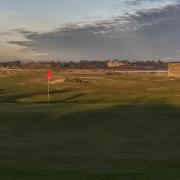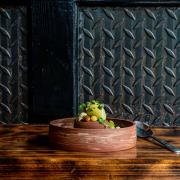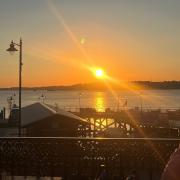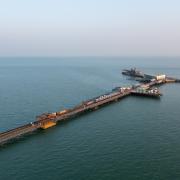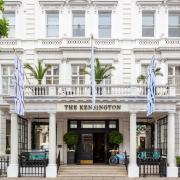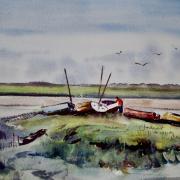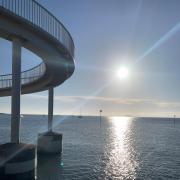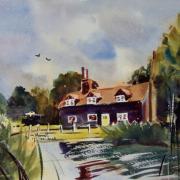On the outskirts of Harlow on Marsh Lane sits a fairly nondescript bungalow surrounded by nine acres of painstakingly designed gardens.
These are the brainchild of the celebrated 20th century leading post-war architect Sir Frederick Gibberd.
Gibberd, the son of a tailor, was the eldest son of five children and grew up in Coventry. Having no interest in the family business he chose a different pathway, and what an extraordinary one it was. Sir Frederick Gibberd was the only architect to have designed a Mosque, a Catholic church and a Cathedral.
Known as the ‘flat architect’ he designed Terminals 1,2 and 3 of Heathrow Airport as well as the Coutts bank building on the Strand. His work, no doubt, took him to extraordinary places both physically and metaphysically and he designed no less than 93 buildings in his lifetime. But he chose to live out his latter days in a bungalow which, with some irony, he didn't get the planning permission he originally sought on the edge of Harlow, despite being the Master Planner of the town.

The gardens were created by Frederick Gibberd over a twenty five year age span starting in 1957 until his death in 1982.
The Gibberd Gardens are now Grade II listed and are held in a Trust. Is it fair to say that it is a place where the house is incidental?
The show stopping features at The Gibberd Garden are what it says on the tin, that being the Garden.
You get a sense that the clean lines and uncluttered nature of the house allowed the residents to fully appreciate the setting of the Modernist garden.
In and around the nine acres are traces of this brilliant architect, Frederick Gibberd.
When he was dismantling Coutts Bank on The Strand, Gibberd ordered the builders to return the giant columns to his property in Harlow. This was quite a task and involved the use of cranes and more.

These huge tall columns can be seen today creating the ‘temple' along with a ‘castle’ constructed of elm logs and accompanying moat. In the ‘whimsical’ garden as it so often referred to, there is also a lime walk, a pool, a grotto and a waterfall.
The gardens are also home to lots of what Gibberd referred to as ‘decorative objects’ including ceramics and as the museum refer to them 'items of architectural salvage.'
There is a bronze cast and a concrete cast of Sir Gibberd displayed in the garden designed by the late Jewish sculptor Gerda Rubinstein who was friends with the couple. Another of Gerda’s sculptors, Mother and Son is also on display in the garden.
This captivating sculpture had to be lovingly restored because in its original setting in Lewisham two men tried to remove it, thus damaging it in the process. It is now safely ensconced in the Gibberd Gardens.
Finally, the Two Formidable Eagles commissioned by Sir Gibberd and also designed by Gerda Rubinstein sit atop the front gates.

Sir Gibberd who by all accounts had a good sense of humour said these were to see off unwanted visitors, possibly rabbits who were attempting to outfox him in the garden. Gerda was by special permission allowed to enter the cage of Goldie the Eagle for further studies at The London Zoo to complete this work of art.. Gerda said that 'I have come to realise that the sense of freedom and hope that I experienced as a teenager in Holland after five years of occupation in World War II has never really left me and that it still colours my work.' Gerda passed away a few years ago.
The house, known as The Gibberd Rooms was originally constructed in 1907 and though Sir Gibberd had some planning challenges of his own, he did succeed in building a large extension on the property. Initially the house was used as a weekend retreat but when his first wife died in 1970 he lived there full time.
His second wife, Patricia was by all accounts a fairly formidable lady. Lady Gibberd was local to the area, though she had formerly grown up in the West Country and was a Labour councillor. Like her husband she had a vision to bring artefacts to the public, one of the fundamental aims of the garden.
Sir Gibberd wished to bequeath the garden to the public but this nearly didn't come to pass when some legal glitches arose. Unfortunately lots of his collected art had to be sold to pay the legal costs. Thankfully all was resolved and a trust was set up, part lottery funded by some local people including Hugh Johnson who resided at Saling Hall further north in Essex near Braintree until very recently and fostered his own interests in gardens.
The Gibberd Rooms are open between 3-5pm on Sundays and tickets can be purchased in the Gift Shop. The cost of viewing the gardens is £6 but there are some concessions for younger children and over 60s. The cost is £2 per person and under 16s go free The Gibberd Gardens are open between 2-5pm until the end of October 2024.






